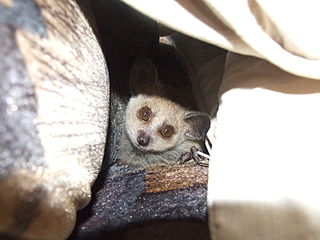
Jackson's mongoose is a mongoose species native to montane forests in Kenya, Uganda and Tanzania. It appears to be rare and has been classified as Near Threatened since 2008.
Fox's shaggy rat is a species of rodent in the family Muridae. It is found only in Nigeria. Its natural habitats are moist savanna, subtropical or tropical seasonally wet or flooded lowland grassland, swampland, and plantations. It is threatened by habitat loss.
Dasymys is a genus of semiaquatic rodents in the subfamily Murinae, the Old World rats and mice. The genus is endemic to Africa.
The African marsh rat or common dasymys is a species of rodent in the family Muridae. It is found in Angola, Democratic Republic of the Congo, Ethiopia, Kenya, Malawi, South Africa, South Sudan, Tanzania, Uganda, Zambia, and Zimbabwe. Its natural habitats are moist savanna, temperate grassland, subtropical or tropical seasonally wet or flooded lowland grassland, and swamps.
The montane shaggy rat is a species of rodent in the family Muridae. It is found in Uganda and possibly Democratic Republic of the Congo. Its natural habitats are subtropical or tropical moist montane forest, subtropical or tropical high-altitude grassland, and swampland. It is threatened by habitat loss. In terms of appearance it is of moderate size compared to others in its genus Dasymys, with dark grey long, fine, hair. It has a fairly short tail compared to its size.
The West African shaggy rat is a species of rodent in the family Muridae. It is found in Benin, Cameroon, Ivory Coast, Gambia, Ghana, Guinea, Guinea-Bissau, Liberia, Mali, Nigeria, Senegal, Sierra Leone, and Togo. Its natural habitats are subtropical or tropical seasonally wet or flooded lowland grassland and swamps. It is a common species and the International Union for Conservation of Nature has rated its conservation status as being of "least concern".
Hylomyscus is a genus of rodent in the family Muridae endemic to Africa.
The Uzungwe vlei rat is a species of rodent in the family Muridae. It is found in Malawi, Tanzania, and Zambia. Its natural habitats are subtropical or tropical high-altitude grassland and swamps. It is threatened by habitat loss.

Brants's whistling rat or Brants' whistling rat is one of two species of murid rodent in the genus Parotomys. It is found in Botswana, Namibia, and South Africa where its natural habitats are subtropical or tropical dry shrubland and pastureland. It was first described in 1834 by the Scottish zoologist Andrew Smith who named it in honour of the Dutch zoologist and author Anton Brants.

Loring's rat is a species of rodent in the family Muridae. It is found in Kenya and Tanzania. Its natural habitats are subtropical or tropical dry forests, dry savanna, and subtropical or tropical dry shrubland.

Grant's bushbaby, also known as Grant's lesser bushbaby or the Mozambique lesser bushbaby, is a species of primate in the family Galagidae. It is found in Malawi, Mozambique, Tanzania, and Zimbabwe. Its natural habitat is subtropical or tropical dry forests. It is a common species and the International Union for Conservation of Nature has assessed its conservation status as being of "least concern".

The red rock hares are the four species in the genus Pronolagus. They are African lagomorphs of the family Leporidae.
Crawford-Cabral's shaggy rat or Crawford-Cabral's shaggy marsh rat is a species of shaggy marsh rat endemic to north-eastern Namibia, near the Okavango River.
The Rwandan shaggy rat is a species of shaggy marsh rat endemic to north-western Rwanda, close to the Virunga Mountains.
The Tanzanian shaggy rat is a species of shaggy marsh rat endemic to eastern Tanzania, near the Uluguru Mountains.

Ansorge's brush-furred rat is a species of rodent in the family Muridae. It was identified in 1896 by de Winton as L. ansorgei. However, it was widely regarded as L. sicapusi until 2000, when Walter Verheyen, Theo Dierckx, and Jan Hulselmans published a study to the Bulletin of the Royal Belgian Institute of Natural Sciences describing it as a distinct species.
Robert's shaggy rat is a species of rodent in the genus Dasymys that lives in South Africa. It was described in 2004.
Verhagen's brush-furred rat is a rodent belonging to the genus Lophuromys. It is found between 2600 and 3050 m on Mount Meru in Tanzania. The species is named after Ronald Verhegen for his contributions to the ecology of small mammals of Tanzania.

Arvicanthini is a tribe of muroid rodents in the subfamily Murinae. Almost all recent species in this tribe are or were found in Africa aside from one species, the Indian bush rat, which is found in South Asia and Iran. However, some fossil Golunda species from India and the genus Parapelomys are thought to have also occurred outside Africa, and one species in the fossil genus Saidomys may have also occurred in Afghanistan.






